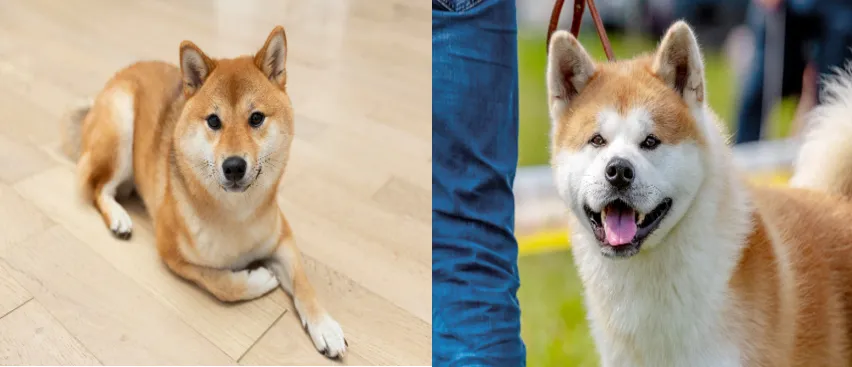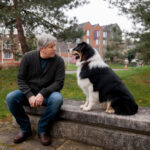If you’ve ever googled “cute Japanese dog breeds,” chances are you’ve come across both the Shiba Inu and the Akita. At first glance, they might look like fluffy cousins—and in a way, they are. But don’t let their foxy faces and curled tails fool you—these two breeds are very different when it comes to personality, size, and lifestyle needs.
So if you’re stuck choosing between the spirited Shiba or the dignified Akita, we’ve got you covered. Let’s break down the main differences and help you figure out which breed fits your vibe best.
Shiba Inu VS Akita : Origins and Historical Background
Shiba Inu Heritage
The Shiba Inu is Japan’s smallest and oldest spitz breed, with roots going back over 2,000 years. Imagine these little hunters weaving through the mountainous forests of Japan, chasing after birds and rabbits. Shibas were prized for their quick reflexes, agility, and sharp senses.
After World War II, the breed came dangerously close to extinction due to food shortages and disease. But thanks to passionate breeders, Shibas made a comeback and are now one of Japan’s most beloved national symbols, and a favorite among dog lovers worldwide.
Akita Inu Heritage
The Akita’s history is just as rich, though their role was much larger — literally! Akitas were developed in northern Japan in the 17th century and were used for hunting big game like boar, deer, and even bears. They weren’t just working dogs, they were considered symbols of good fortune and often lived in noble households.
Akitas became internationally famous thanks to the story of Hachiko, the loyal Akita who waited at a train station for his owner who had passed away. For nearly 10 years, Hachiko waited faithfully, touching the hearts of people all over the world.
Size and Physical Characteristics
Size Differences
Perhaps the most obvious difference between these breeds is their size. Shiba Inus are compact, medium-sized dogs weighing between 17-23 pounds and standing 13.5-16.5 inches tall. Akitas are significantly larger, with males weighing 100-130 pounds and females 70-100 pounds, standing 24-28 inches tall. This substantial size difference makes the choice between breeds partly dependent on your living situation and physical capabilities.
Physical Appearance
Both breeds share the distinctive spitz characteristics including erect triangular ears, curled tails, and double coats, but their proportions differ significantly. Shiba Inus have a more compact, athletic build with a fox-like expression and alert demeanor. Their movements are quick and agile, reflecting their hunting background.
Akitas possess a more substantial, powerful build with broader heads and more bear-like features. Their presence is imposing and dignified, with a calm, confident bearing that reflects their guardian heritage. Both breeds come in similar color variations including red, black and tan, and cream, though Akitas also come in white and brindle patterns.
Temperament and Personality
Shiba Inu Temperament
Shibas are bold, confident, and fiercely independent. Many people say they act more like cats than dogs, they like affection on their own terms and aren’t usually clingy. They’re curious and clever but also have a stubborn streak.
Shibas are alert and make great watchdogs. They’re not aggressive, but they’ll let you know if something’s up. Around strangers, they can be reserved, and they might try to dominate other dogs, especially those of the same sex.
And of course, there’s the famous Shiba scream. If they’re frustrated, excited, or don’t like what’s happening, they’ll let out a loud, high-pitched howl that surprises many first-time owners!
Akita Temperament
Akitas are known for their dignity and deep loyalty. They form strong bonds with their family and are protective without being unnecessarily aggressive. They’re calm and usually quiet, they don’t bark much unless there’s a reason.
While they’re incredibly loyal, Akitas can be wary of strangers and often don’t do well with other pets, especially smaller animals or dogs of the same sex. They have a strong guarding instinct and need to be part of a family that understands how to manage it.
Akitas aren’t the type of dog that wants to be friends with everyone, they’re selective, and that’s part of their charm.
Exercise and Activity Needs
Shiba Inu Exercise Requirements
Shiba Inus are moderately active dogs that require daily exercise but are adaptable to various living situations. A daily walk combined with some playtime in a securely fenced yard is usually sufficient. They enjoy mental stimulation through puzzle toys and training exercises. Shibas can adapt well to apartment living provided their exercise needs are met, though they appreciate having access to outdoor space.
Akita Exercise Requirements
Akitas have moderate exercise needs but require more space due to their size. They benefit from daily walks and enjoy activities like hiking, but they’re not as high-energy as some other large breeds. Akitas prefer cooler weather and may be less active during hot summer months due to their thick double coat. They need a securely fenced yard and are not suitable for apartment living due to their size and protective nature.
Training and Socialization
Training Considerations for Shiba Inus
Training a Shiba Inu requires patience, consistency, and creativity. Their independent nature means they’ll often choose when and how to respond to commands. Positive reinforcement works best, though owners must be prepared for the breed’s selective hearing. Early socialization is crucial to prevent resource guarding and to ensure they’re comfortable with various people, animals, and situations.
Training Considerations for Akitas
Akita training requires an experienced, confident owner who can provide firm, consistent leadership without being harsh. They’re intelligent and capable learners but need clear boundaries and structure. Early and ongoing socialization is absolutely critical for Akitas, as their natural wariness of strangers and other dogs can develop into problematic behaviors without proper guidance.
Grooming and Maintenance
Shiba Inu Grooming Needs
Shiba Inus have a double coat that requires regular maintenance. They shed moderately year-round with heavy shedding periods twice annually, often called “blowing coat.” During these times, daily brushing is necessary to manage the substantial amount of loose fur. Regular nail trimming, ear cleaning, and dental care are also important aspects of their grooming routine.
Akita Grooming Needs
Akitas have similar grooming needs but on a larger scale. Their thick double coat requires regular brushing, particularly during shedding seasons when they can lose enormous amounts of fur. The grooming process takes longer due to their size, and owners should be prepared for significant amounts of hair throughout their homes during shedding periods.
Health Considerations
Shiba Inu Health Issues
Shiba Inus are generally healthy dogs with a lifespan of 12-15 years. However, they can be prone to certain genetic conditions including hip dysplasia, luxating patella, eye problems, and allergies. Responsible breeding practices have helped reduce the incidence of these issues, making health testing of breeding stock important when selecting a puppy.
Akita Health Issues
Akitas have a shorter lifespan of 10-13 years and can be prone to several serious health conditions including hip dysplasia, bloat (gastric torsion), thyroid problems, and certain autoimmune conditions. Their large size makes them susceptible to joint problems, and their deep chest increases the risk of life-threatening bloat.
Living Situations and Family Compatibility
Shiba Inus as Family Pets
Shiba Inus can make excellent family pets for the right households. They’re generally good with children who understand how to interact respectfully with dogs, though they may not tolerate rough play. Their moderate size makes them manageable for most families, and they can adapt to various living situations including apartments with sufficient exercise.
Akitas as Family Pets
Akitas are best suited for experienced dog owners who understand large, powerful breeds. They can be wonderful family companions but require careful management around children and other pets. Their size and protective nature make them unsuitable for first-time dog owners or families with very young children who might inadvertently trigger the dog’s protective instincts.
Cost Considerations
Initial and Ongoing Costs
Both breeds represent significant financial commitments, but Akitas generally cost more due to their size. Food costs, veterinary bills, grooming supplies, and boarding fees are all higher for larger dogs. Quality puppies from reputable breeders can cost $1,500-$3,500 for Shiba Inus and $1,200-$4,000 for Akitas, depending on lineage and location.
Making the Right Choice
Choosing between a Shiba Inu and an Akita depends on multiple factors including your experience with dogs, living situation, activity level, and personal preferences. Shiba Inus are better suited for those who want a smaller, more manageable dog with moderate exercise needs and can appreciate their independent, sometimes aloof personality. They’re ideal for owners who enjoy a dog with personality and don’t mind a bit of stubbornness.
Akitas are better suited for experienced dog owners who want a loyal, protective companion and have the space, time, and resources to properly care for a large breed. They’re ideal for those who appreciate a dignified, calm dog that forms deep bonds with their family.
Conclusion
Both Shiba Inus and Akitas are remarkable breeds that can make wonderful companions for the right owners. While they share Japanese heritage and some physical similarities, their differences in size, temperament, exercise needs, and care requirements make each breed suitable for different types of households. Potential owners should carefully consider their lifestyle, experience level, and long-term commitment before choosing either breed.
Regardless of which breed you choose, both Shiba Inus and Akitas require dedicated owners who understand their unique characteristics and are committed to providing proper training, socialization, and care throughout their lives. With the right match between dog and owner, either breed can provide years of loyal companionship and joy.




